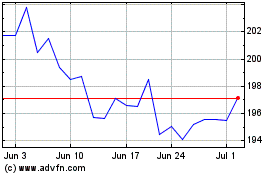U.S. Bond Prices Weaken as Investors Move Into Riskier Assets
April 20 2016 - 4:48PM
Dow Jones News
By Sam Goldfarb
U.S. government bond prices weakened on Wednesday, as a jump in
oil prices led investors to favor riskier assets.
The yield on the benchmark 10-year Treasury note settled at
1.852%, compared with 1.783% on Tuesday, marking its largest
one-day gain since March 1. Yields rise when bond prices fall.
In recent months, oil prices have been taken as a proxy for the
health of the global economy, with stock prices climbing when those
of commodities rise and falling when they drop. Investors on
Wednesday were seen moving out of bonds and into stocks.
Although Treasurys spent much of the morning treading water,
yields jumped in concert with oil prices, outpacing a similar move
by the S&P 500 stock index, said Mark Cabana, U.S. rates
strategist at Bank of America Merrill Lynch in New York. After
failing to rise as much as stock prices earlier in the week,
government bonds [yields] are playing "a little bit of catch up,"
he said.
Before the sudden increase, the yield on the 10-year had barely
budged over several days, hovering just below the 1.8% level to
which it has hewed closely for more than two months.
Analysts say several factors are keeping U.S. bonds where they
are. Subdued inflation, aggressive monetary-stimulus programs
overseas and signals from the Federal Reserve that it is no hurry
to raise interest rates all make Treasurys look attractive to
investors. Yet easing concerns about the global economy, rising
equities prices and the occasional warning from Fed officials about
complacency are simultaneously bolstering yields.
"Investors were very concerned that the global economy was going
into a recession, and we've learned subsequently that the global
economy is not crashing," said Andrew Wilkinson, chief market
analyst at Interactive Brokers. Still, "there's a very strong
message coming from the Fed that interest rates will be lower for
longer," he said.
This week, the disconnect between stocks and bonds became stark,
as the Dow Jones Industrial Average closed above 18000 for the
first time since July, while the 10-year Treasury yield traded at
less than 0.4 percentage point from its record closing low, set in
the summer of 2012.
A concern for bond buyers is that the diverging course of stocks
and bonds could presage a large selloff of Treasurys, which may
have been previewed on Wednesday. But history suggests the gap
between the two assets may need to get wider before that happens,
Mr. Cabana said.
Federal Reserve Bank of Boston President Eric Rosengren said
late on Monday that traders and investors are seriously
underestimating how many rate rises the U.S. central bank is likely
to deliver over the next few years. But fed-fund futures, used by
investors and traders to place bets on central bank policy, still
show only a 21% likelihood of a rate increase from the Fed at its
June 2016 policy meeting, according to data from CME Group.
Corporate bond sales have also picked up recently, as companies
take advantage of low yields to lock in favorable funding costs.
And Argentina's first bond sale since its default in 2001 drew
strong demand, underscoring the appetite from investors for riskier
forms of debt.
An influx of corporate and sovereign bonds often leads investors
to lighten up on Treasurys, though selling before Wednesday was
muffled by buyers taking advantage of cheaper prices, analysts
said.
COUPON ISSUE Price CHANGE YIELD CHANGE
7/8% 2-year 100 4/32 dn 3/32 0.806% +4.8BPS
7/8% 3-year 99 22/32 dn 6/32 0.981% +6.4BPS
1 1/4% 5-year 99 21/32 dn 11/32 1.320% +7.0BPS
1 1/2% 7-year 99 5/32 dn 16/32 1.631% +7.4BPS
1 5/8% 10-year 97 31/32 dn 20/32 1.852% +6.9BPS
2 1/2% 30-year 96 24/32 dn 1 10/32 2.659% +6.5BPS
2-10-Yr Yield Spread: +104.6BPS vs + 102.5BPS
Source: Tradeweb/WSJ Market Data Group
Write to Sam Goldfarb at sam.goldfarb@wsj.com
(END) Dow Jones Newswires
April 20, 2016 16:33 ET (20:33 GMT)
Copyright (c) 2016 Dow Jones & Company, Inc.
CME (NASDAQ:CME)
Historical Stock Chart
From Mar 2024 to Apr 2024

CME (NASDAQ:CME)
Historical Stock Chart
From Apr 2023 to Apr 2024
